#December 1614
Explore tagged Tumblr posts
Text
Baroque Winter Landscapes - The Sims 4 Loading Screens

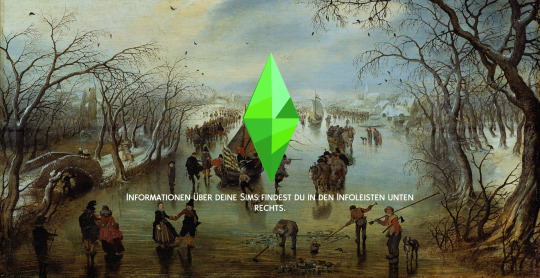
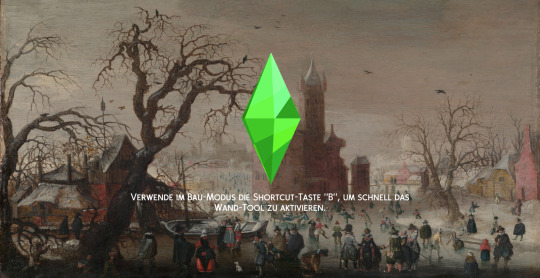


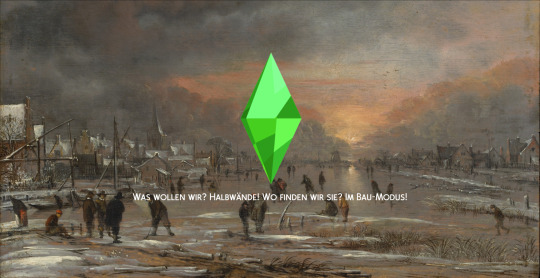
Much to my surprise I noticed it's December again and so I went looking for some winter-themed loading screens, but couldn't find any in the style and with the mood I had in mind. So, thanks to this great and very helpful Sims 4 Studio tutorial by sigma1202, I could create some myself!
This pack includes six baroque landscape paintings of Dutch and Flemish painters of the 17th (and late 16th) century. So you get some beautiful winter sceneries, snow-covered houses, lots of people ice-skating and many more details to discover while you're waiting for your game to load (which, as we know, can take its time...). Plus, I feel the atmosphere somehow perfectly fits the time before Christmas.
Download here (Google Drive, free)
You can download them seperately or all together in a zip.file. Please make sure to only place ONE loading screen in your mods folder at a time!
Please let me know if you encounter any issues!
You can find details about the paintings I used under the cut:
So downwards and always from left to right, we've got:
01 - Lukas van Valckenborch, View of Antwerp with Frozen Schelde, 1593, Städel-Museum Frankfurt am Main
02 - Adriaen Pietersz van de Venne, Winter, 1614, Staatliche Museen zu Berlin
03 - Christoffel van den Berghe, A Winter Landscape with Ice Skaters and an Imaginary Castle, ca. 1615-20, Met Museum New York
04 - Jan Brueghel the Younger (attributed), Snowy Landscape, after 1625, Museo del Prado Madrid
05 - Aert van der Neer, Winter Landscape with Ice Skaters at Sunset, 1655/60, Staatliche Museen zu Berlin
06 - Aert van der Neer, Sports on a Frozen River, ca. 1660, Met Museum New York
The links lead to the paintings in the respective museum's online collection, in case you want to know more details or take a closer look at them without a rotating plumbob in the way 😅
#the sims 4#sims 4#ts4#the sims 4 loading screens#sims 4 loading screens#ts4 loading screens#loading screens#loading screen#the sims 4 loading screen#sims 4 loading screen#ts4 loading screen
70 notes
·
View notes
Text
kehribar-sultan: Well thakns four your appreciation, yeah, I really tried hard......But, first I would like to say some words about your comment: 1) I would like to get your acceptance and recognition of possibility that Safiye had all of these four daughters. I would stress out that ambassadors only talked about children of the Topkapi Palace who were notable in political life (case with Murad IV’s four full sisters). I do not agree with you, Ahmed Pasha (Mirahur in 1604) was named governor of Rumelia two times; firstly in 1614 and secondly in 1614. And he wasn’t Aga of the jannisaries. The Pasha you’ve mentioned is someone else. Beside, I found in Dumas’s 2013 book that Mihrimah was same as Mihriban (page 82, note 171). Anyway, she died in early 1610s I quess, and her husband remarried to her half-sister Fahri Sultan in September 1613. Anyway, I suggest that Mihrimah was the eldest, as I proved in citations that Mehmed had a two years older sister than him. Also, I (most strongly) suggest that Hümaşah was Safiye’s daughter, even the youngest, as her husband Hasan Pasha was placed in Divan of Ahmed I, and he referred to her as halem. 2) I didn’t get your comment about suggested (officially unknown) sons-in-law of Murad III, such as Boyali Mehmed Pasha, Siyavush Pasha (failed) and Serdar Ferhad Pasha. I mean, all that marriage negotiations in early 1590s prove that Safiye had more than two daughters. 3) I would suggest that Murad III’s daughters Saime and Fahri were his longest-living daughters, who died in late reign of Mehmed IV (Hümaşah, Beyhan and Hatice died in early reign of Mehmed IV). Anyway, I need to stress out that Fahri’s full name was Fahrihan (source: https://www.isam.org.tr/uploads/6595588ee2276.pdf - page 494 ; also there is Saime too – page 138) 4) I have suspitions that Murad III had one more daughter named Asüde Sultan, but I won’t claim it until I am sure it was his daughter.
I’m sorry if my answers are lacking but it’s just a lot of information to process fast and sometimes I get lost in the labyrinth of Ottoman princesses.
I never said Safiye couldn’t have been their mother. I said that since both Mihrimah and Hümaşah were important people in Murad III’s life, if he ever wanted to honour them he would have done it with his eldest daughters, hence Safiye’s.
I do not agree with you, Ahmed Pasha (Mirahur in 1604) was named governor of Rumelia two times; firstly in 1614 and secondly in 1614. And he wasn’t Aga of the jannisaries. The Pasha you’ve mentioned is someone else
Oh sorry, I copied my notes into the ask. I couldn’t understand what you were talking about until i saw my note in brackets lol. I thought it was him because Öztuna says that Mirahur Ahmed Pasha was, among other things, Janissaries commander and then governor of Rumelia:
=Dâmâd Mîrâhûr Ahmed Paşa (ölm.Ist.1618), izd.21.2.1613, izd.müd.5 yıl. Enderun, çukadâr 1612, hâsodabaşı, mîrâhûr 1613, yeniçeri ağacı 10.1613, vezâret'le Rumeli beyl.2.1614, Şâm 1617-8, mâzûl
I think I’m starting to see why you say that Mihrimah was Safiye’s eldest daughter. It took me a long time (bc i’m stupid) but I’m starting to see the light lol. If Matteo Zane is correct, and this princess was 26 years old in 1592 then there was definitely another daughter of Safiye who, for some reason, was unmarried at the time. If Mihrimah is Murad III’s eldest child then he definitely wanted to honour his beloved aunt (whom he honoured again when she died, burying her next to Süleyman).
I do agree that Hümaşah seems to be the youngest daughter of Safiye.
So, basically, Safiye’s children could be:
A princess (Mihrimah) born in 1564 circa
Mehmed III, born in May 1566
Süleyman, born in 1568-69 (the Venetians say he was two years younger than Mehmed) (he must have died before 1576, when another Süleyman was born)
Ayşe, born in 1569-70
Mahmud, born in July 1572
Fatma, born in 1574
Süleyman, born in December 1576 (and died in 1577)
Selim, born in December 1578
Hümaşah, born in 1580 (?) (though Sakaoğlu says she was born in Manisa)
Öztuna says that a Şehzade Mustafa was born in “1578?” and a Şehzade Osman was born in “1573” in Manisa. Osman was the eldest after Mehmed and died in 1587. Mustafa was executed by Mehmed III in 1595 and was the prince Canfeda had tried to save before being dismissed. Unfortunately Pedani didn’t source this claim, I would have loved to know more about this. These two princes though do not figure in “A COMPARISON OF SEYYID LOKMAN’S RECORDS OF THE BIRTH, DEATH AND WEDDING DATES OF MEMBERS OF OTTOMAN DYNASTY (1566-1595) WITH THE RECORDS IN OTTOMAN CHRONICLES”, so I don’t know. On the other hand, Karaçelebizâde says that the eldest prince executed by Mehmed III was born in 1585… which would make more sense.
Considering that Safiye was sent away to the Old Palace in 1583 and that the Venetian ambassador already reported that she could not have any more children (”seeing that she got ugly and could no longer have children”, dispatch dated 18 September 1583), I’d say that Hümaşah was the latest child she had (or maybe she had a miscarriage/difficult birth afterwards which sealed her condition). Selaniki, on the other hand, says that a 2yo princess died on 29 July 1585… maybe she was Safiye’s last child?
I didn’t get your comment about suggested (officially unknown) sons-in-law of Murad III, such as Boyali Mehmed Pasha, Siyavush Pasha (failed) and Serdar Ferhad Pasha. I mean, all that marriage negotiations in early 1590s prove that Safiye had more than two daughters.
Sorry about that!! So, I didn’t say anything because I thought that what you said made perfectly sense; I had nothing to add. I googled Ferhad Pasha and Wikipedia said that he tried to escape execution by appealing to Safiye. Unfortunately there is no source but it would make sense if he was her son-in-law. Where did you find that Nişancı Mehmed Pasha was governor of Rumelia in 1591? I swear I can’t find it anywhere.
I would suggest that Murad III’s daughters Saime and Fahri were his longest-living daughters, who died in late reign of Mehmed IV (Hümaşah, Beyhan and Hatice died in early reign of Mehmed IV). Anyway, I need to stress out that Fahri’s full name was Fahrihan
Saime stops being mentioned by Ragusian diplomats after 9 August 1670, while Farhi or Fahrihan (which I really like) is mentioned until 9 May 1679 as “Pahari” (unless it’s someone else but that’s the last time someone with a similar name was mentioned).
I’m going to read about Asüde Sultan soon, I’ve seen your message in my inbox :D
11 notes
·
View notes
Photo

The Infamous + Violent Elizabeth Bathory
Countess Elizabeth Bathory, or Erzsébet Báthory, was a wealthy and powerful Hungarian noblewoman. In 1610 she was accused of gruesome acts of serial murder and confined to her home of Castle Čachtice, where she remained until her death. Bathory is reputed to have killed at least six hundred victims, earning her a Guinness World Record for most prolific female murderer.
Bathory was accused of a haunting litany of crimes against both female servants and minor noblewomen who'd come to her for training and education. Most of her alleged assaults and murders took place after she was widowed in 1604.
Some of Bathory's victims were covered with honey and left outside for insects to devour. During colder parts of the year young women might be stripped naked and forced into deadly ice baths. Bathory sometimes tortured girls by driving needles into their fingers, cutting their noses or lips or whipping them with stinging nettles. She would bite shoulders and breasts, as well as burning the flesh, including the genitals, of some victims. The intimate nature of Bathory's attacks suggests a sexual motivation, though it's impossible to know with certainty what compelled her to act.
Depictions of Bathory often mention her bathing in the blood of virgin victims in an attempt to recapture her lost youth. However, this depraved action isn't backed up by contemporaneous witness accounts (which otherwise didn't shy away from gore). The first mention of Bathory's blood baths came 100 years after her death and thus seems to be an invention.
On December 29, 1610, Count György Thurzó, who oversaw judicial matters as the lord palatine of Hungary, arrived at Bathory's Castle Čachtice to investigate the countess' alleged crimes against women of noble birth (any mistreatment of servants was not a concern to authorities). He reportedly surprised Bathory in the middle of tormenting a victim and in response immediately imprisoned her in her home (her high status meant she would not be jailed as a common criminal).
Four of Bathory's servants — three females and one male — were then arrested, questioned, and subjected to torture. Their court proceedings began early in January 1611. These servants denied their culpability in the murders but admitted to burying multiple victims, though the number in their accounts varied between 36 and 51. In addition to shifting blame to their mistress and each other, they also implicated a deceased servant, Darvulia, who'd served as a maid and governess. Two of the women and the male servant were sentenced to death, which was quickly carried out. The fourth was spared immediate execution; what happened to her afterward is unknown. Another woman, who'd supposedly used magic to aid Bathory, was also soon killed.
After these executions Thurzó continued to investigate the countess. One witness stated that Báthory herself had listed 650 victims in her papers, though the number of victims varied in other testimonials and the countess' exact death toll remains unknown. The evidence gathered by Thurzó also included 289 witness statements.
As a member of a powerful family, Bathory was not put on trial. Instead, she was isolated — perhaps walled up — in Castle Čachtice, where she remained until her death in 1614.
26 notes
·
View notes
Photo

Daniel van den Dyck - Portrait of a Nobleman - 1650s
oil on canvas, height: 98.5 cm (38.7 in); width: 79.5 cm (31.2 in)
Daniel van den Dyck, known in Italy as Daniel Vandich (baptized on 3 December 1614, Antwerp – 1663, Mantua) was a Flemish painter, printmaker, architect and engineer. After training in Antwerp he left for Italy where he first worked in Venice and later became a court painter in Mantua. He was a versatile artist who created mythological and religious scenes, as well as portraits and flower-pieces.
23 notes
·
View notes
Text

The Infamous + Violent Elizabeth Bathory
Countess Elizabeth Bathory, or Erzsébet Báthory, was a wealthy and powerful Hungarian noblewoman. In 1610 she was accused of gruesome acts of serial murder and confined to her home of Castle Čachtice, where she remained until her death. Bathory is reputed to have killed at least six hundred victims, earning her a Guinness World Record for most prolific female murderer.
Bathory was accused of a haunting litany of crimes against both female servants and minor noblewomen who'd come to her for training and education. Most of her alleged assaults and murders took place after she was widowed in 1604.
Some of Bathory's victims were covered with honey and left outside for insects to devour. During colder parts of the year young women might be stripped naked and forced into deadly ice baths. Bathory sometimes tortured girls by driving needles into their fingers, cutting their noses or lips or whipping them with stinging nettles. She would bite shoulders and breasts, as well as burning the flesh, including the genitals, of some victims. The intimate nature of Bathory's attacks suggests a sexual motivation, though it's impossible to know with certainty what compelled her to act.
Depictions of Bathory often mention her bathing in the blood of virgin victims in an attempt to recapture her lost youth. However, this depraved action isn't backed up by contemporaneous witness accounts (which otherwise didn't shy away from gore). The first mention of Bathory's blood baths came 100 years after her death and thus seems to be an invention.
On December 29, 1610, Count György Thurzó, who oversaw judicial matters as the lord palatine of Hungary, arrived at Bathory's Castle Čachtice to investigate the countess' alleged crimes against women of noble birth (any mistreatment of servants was not a concern to authorities). He reportedly surprised Bathory in the middle of tormenting a victim and in response immediately imprisoned her in her home (her high status meant she would not be jailed as a common criminal).
Four of Bathory's servants — three females and one male — were then arrested, questioned, and subjected to torture. Their court proceedings began early in January 1611. These servants denied their culpability in the murders but admitted to burying multiple victims, though the number in their accounts varied between 36 and 51. In addition to shifting blame to their mistress and each other, they also implicated a deceased servant, Darvulia, who'd served as a maid and governess. Two of the women and the male servant were sentenced to death, which was quickly carried out. The fourth was spared immediate execution; what happened to her afterward is unknown. Another woman, who'd supposedly used magic to aid Bathory, was also soon killed.
After these executions Thurzó continued to investigate the countess. One witness stated that Báthory herself had listed 650 victims in her papers, though the number of victims varied in other testimonials and the countess' exact death toll remains unknown. The evidence gathered by Thurzó also included 289 witness statements.
As a member of a powerful family, Bathory was not put on trial. Instead, she was isolated — perhaps walled up — in Castle Čachtice, where she remained until her death in 1614.
11 notes
·
View notes
Text
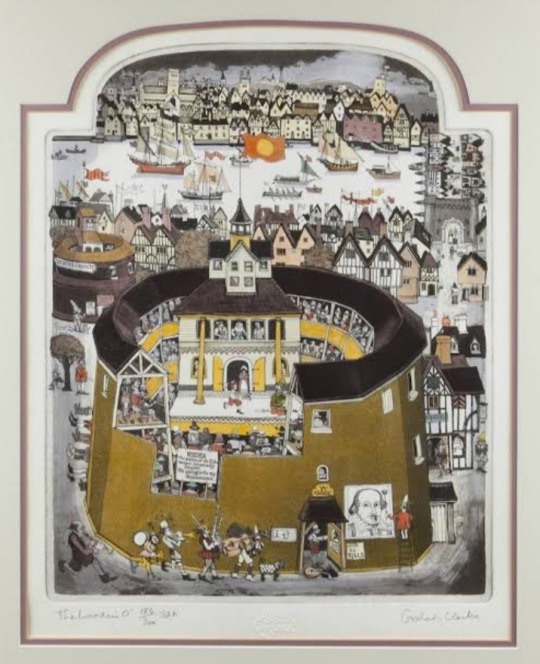
Shakespeare's Globe Theatre.
The story of Globe Theatre started with William Shakespeare's acting company, Lord Chamberlain's Men.
William Shakespeare (baptized 26 April 1564 – 23 April 1616) was a part-owner or sharer in the company, as well as an actor and resident playwright.
From its inception in 1594 AD, Lord Chamberlain's Men performed at Theatre, a playhouse located in Shoreditch.
However, by 1598, their patrons, including Earl of Southampton, had fallen out of favour with the Queen.
Theatre's landlord, Giles Alleyn, had intentions to cancel the company's lease and tear the building down.
While Alleyn did own the land, he did not own the materials with which the theatre had been built.
So, on 28 December 1598, after leasing a new site in Southwark, Cuthbert and Richard Burbage led the rest of the company of actors, sharers, and volunteers in taking the building down, timber by timber, loading it on to barges, and making their way across Thames.
Working together, the actors built the new theatre as quickly as they could.
The ground on the new site was marshy and prone to flooding, but foundations were built by digging trenches, filling them with limestone, constructing brick walls above stone, and then raising wooden beams on top of that.
A funnel caught rainwater and drained it into ditch surrounding the theatre and down into Thames.
The theatre was 30m in diameter and had 20 sides, giving it its perceived circular shape.
Structure was similar to that of their old theatre, as well as that of the neighbouring bear garden.
The rectangular stage, at 5ft high, projected halfway into the yard and circular galleries.
Pillars were painted to look like Italian marble, sky painted midnight blue, and images of gods overlooked balcony. It could hold up to 3,000 people.
By May 1599, the new theatre was ready to be opened.
Burbage named it Globe after the figure of Hercules carrying the globe on his back — for in like manner, the actors carried Globe's framework on their backs across Thames.
A flag of Hercules with globe was raised above theatre with Latin motto: 'totus mundus agit histrionem' ('all the world's a playhouse').
Shakespeare's plays that were performed there early on included:
Henry V, Julius Caesar, As You Like It, Hamlet, Measure for Measure, Othello, King Lear, Macbeth, and Antony and Cleopatra.
Here, the Lord Chamberlain's Men enjoyed much success and gained the patronage of King James I in 1603, subsequently becoming The King's Men.
During a fateful performance of Henry VIII on 29 June 1613, a cannon announcing the unexpected arrival of the king at the end of Act 1 set fire to the thatched roof, and within an hour, the Globe burned to ground.
Everyone escaped safely, save for one man whose breeches reportedly caught fire. Two different songs had been written about it by the next day.
Globe was rebuilt by February 1614. The company could then afford to decorate it extravagantly, and it had a tiled roof instead of thatched.
However, by this point, Shakespeare's influence had lessened. He was spending more and more time back in Stratford-upon-Avon.
Disaster struck again in 1642 when the Parliament ordered the closure of London theatres.
In 1644-45, Globe was destroyed and the land sold for building.
In 1970, American actor and director, Samuel Wanamaker CBE (born Wattenmacker; 14 June 1919 – 18 December 1993), set up the Shakespeare's Globe Trust to pursue his dream of reconstructing the original Globe Theatre.
For what would be almost the next 30 years, he and his team worked and fought to obtain the permissions, funds, and research necessary for a project of this scope.
Historians, scholars and architects all worked together in their efforts to build the Globe in the same way Lord Chamberlain's Men did, down to the green oak pillars and thatched roof.
Their work and dreams were fulfilled when the new Globe Theatre opened in 1997, one street away from where original stood.
Globe stands today as a living monument to Shakespeare, greatest English playwright, home to productions of his plays and many other new ones every season.
#William Shakespeare#Globe Theatre#Elizabethan Age#Jacobean Age#British theatre#English Renaissance#Early Modern Period#actor#playwright#writer#Lord Chamberlain's Men#Queen Elizabeth I#Giles Alleyn#1500s#16th century#King James I#The King's Men#1600s#17th century#Samuel Wanamaker#Shakespeare's Globe Trust#theatres#plays
6 notes
·
View notes
Text
A wedding Coronation and a surprise...
A wedding, Coronation and a surprise... https://ift.tt/ImUwtS9 by Multislushie Book two! If you haven't read book one I recommend you do. Words: 1614, Chapters: 1/?, Language: English Series: Part 2 of Adventures of Prince Henry and Consort Alex Fandoms: Red White & Royal Blue - Casey McQuiston, Red White & Royal Blue (2023) Rating: Teen And Up Audiences Warnings: Major Character Death, No Archive Warnings Apply Categories: F/M, M/M Characters: Alex Claremont-Diaz, Henry Fox-Mountchristen-Windsor, Nora Holleran, June Claremont-Diaz, Beatrice Fox-Mountchristen-Windsor, David the Beagle (Red White & Royal Blue), Philip Fox-Mountchristen-Windsor, Martha Fox-Mountchristen-Windsor, Catherine Fox-Mountchristen-Windsor, King James III (Red White & Royal Blue), Ellen Claremont, Oscar Diaz (Red White & Royal Blue), Liam (Red White & Royal Blue), Zahra Bankston, Shaan Srivastava, Amy Chen | Amy Gupta, Amy Chen | Amy Gupta's Wife Relationships: Alex Claremont-Diaz/Henry Fox-Mountchristen-Windsor, Martha Fox-Mountchristen-Windsor/Philip Fox-Mountchristen-Windsor, Zahra Bankston/Shaan Srivastava, Nora Holleran/Percy "Pez" Okonjo, Ellen Claremont/Oscar Diaz Additional Tags: Mpreg, Implied Mpreg, Post Mpreg, Fluff, Fluff and Humor, Tooth-Rotting Fluff, Romance, Fluff and Smut, Pregnancy, Pregnant Henry Fox-Mountchristen-Windsor, Weddings, coronation ceremony, Husbands in love, LGBTQ Character, Children of Characters, Don't Like Don't Read, Idiots in Love, Please Don't Hate Me, Based on film more than book, Love, How Do I Tag, I'm Bad At Summaries, i love these characters, Other Additional Tags to Be Added via AO3 works tagged 'Alex Claremont-Diaz/Henry Fox-Mountchristen-Windsor' https://ift.tt/u46w2m9 December 10, 2023 at 07:17AM
2 notes
·
View notes
Link
Mirza Raja Man Singh I was the 24th Maharaja of Amber from 1589 to 1614. He also served as the Subahdar of Bengal for three terms from 1595 to 1606 and the Suba...
Link: Man Singh I
0 notes
Text





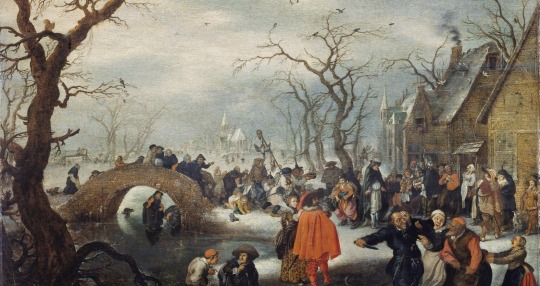
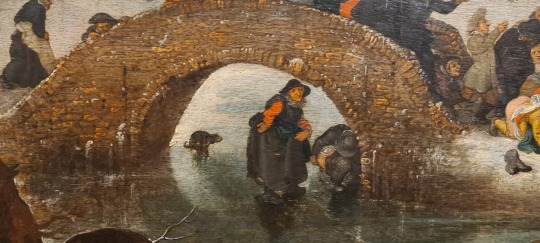


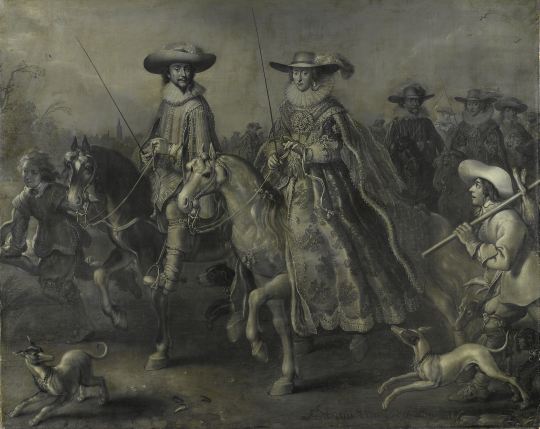
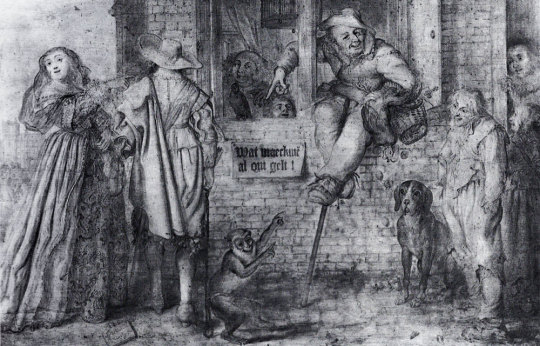
Wat? Zelfportret (1615-1618), Het vertrek van een hoogwaardigheidsbekleder uit Middelburg (1615), De winter (1614), De winter (1625) met detail, Boerenvastenavond (ca. 1625) met detail, De Schilder-winckel (1623), Zeeuwsche Nachtegael (1623), Frederik V, keurvorst van de palts, koning van Bohemen, en zijn echtgenote Elizabeth Stuart te paard (1626) en ‘Wat maeckme[n] al om gelt!’ (1631) door Adriaen van de velde
Waar? Tentoonstelling De omgekeerde wereld van Adriaen van de Venne in het Zeeuws Museum, Middelburg
Wanneer? 27 december 2023
Adriaen van de Venne (1590-1662) is voor veel mensen een onbekende kunstenaar. Zelf kende ik voor het zien van de tentoonstelling in het Zeeuws museum één werk van hem: De zielenvisserij. In dat schilderij wordt weergegeven hoe protestanten en katholieken proberen de meeste zieltjes op te vissen. Dit schilderij ontbreekt helaas op deze expositie, maar wat er wél hangt is ook zeker de moeite waard en laat zien hoe veelzijdige Van de Venne was. Hij was schilder, dichter en ontwerper van prenten en boekillustraties.
Het vertrek van een hoogwaardigheidsbekleder uit Middelburg toont waarschijnlijk het vertrek van de graaf van Nothingham, Charles Howard, opperbevelhebber van de Engelse vloot tegen de Spaanse Armada. Ook de Zeeuws-Hollandse vloot had aan deze strijd deelgenomen. Op de achtergrond zien we een fraai panorama van de stad Middelburg met onder meer het stadhuis en de Nieuwe Kerk.
Van de Venne schilderde vaak de seizoenen in de vorm van landschappen. Soms als tweetal van alleen zomer en winter, soms als serie van alle vier seizoenen. Niet zozeer de seizoensgebonden activiteiten staan bij Van de Venne centraal, maar aanvankelijk vooral het vermaak van de elite en later met name de onhebbelijkheden van het gewone volk. De titel van de Middelburgse expositie is ontleend aan het feit dat de kunstenaar in veel van zijn werk laat zien hoe het niet hoort.
Op Boerenvastenavond trekt een carnavaleske optocht door het dorp. Rechts op de voorgrond gaan een aantal dorpsbewoners met elkaar op de vuist. Zowel Boerenvastenavond als Winter tonen een poepende man, met op enige afstand een hond die hetzelfde zit te doen. Het gedrag van de mens lijkt niet veel beter dan dat van een simpel dier.
Vanaf 1618 gaat Adriaen nauwer samenwerken met zijn broer Jan, die zich als prentverkoper in Middelburg heeft gevestigd. In 1618 vestigt Jan een uitgeverij, drukkerij en kunsthandel aan de Korte Burg, die bekend wordt onder de naam Schildery-winckel. De meeste ontwerpen voor prenten en boekillustraties worden door Adriaen aangeleverd. In 1623 neemt Jan een drukpers in gebruik, met als eerste publicatie de dichtbundel Zeeuwsche Nachtegaal. Deze bundel is een samenwerking tussen Zeeuwse dichters met als doel Zeeland cultureel op de kaart te zetten. Naast alle illustraties levert Adriaen ook een gedicht waarin de innige relatie tussen schilder- en dichtkunst centraal staat.
Na zijn vertrek naar Den Haag gaat Adriaen van de Venne zich specialiseren in het gebruik van de grisailletechniek: het schilderen in nuances van één kleur. Zelden is deze techniek eerder gebruikt voor op zichzelf staande schilderijen. Van de Venne doet dit wel, bijvoorbeeld in het portret van Frederik V en Elizabeth Stuart te paard. Maar hij maakt ook veel ‘grauwtjes’, zoals de grisailles genoemd worden, met als hoofdonderwerp boeren of bedelaars, die zich niet gedragen zoals het hoort. Op ‘Wat maeckme[n] al om gelt!’ zien we een boer die op het punt staat een bordeel binnen te gaan. Het opschrift slaat op de vrouw achter het venster, die zichzelf verkoopt voor geld. In het bordeel zal de boer beroofd worden van zijn geld, zodat hij al het geld dat hij met zijn waren in de stad heeft verdiend, weer verliest. Moraal: hou je seksuele lusten in bedwang.
1 note
·
View note
Text
Darya Nikolayevna Saltykova (Russian: Да́рья Никола́евна Салтыко́ва; née Ivanova, Ива́нова; March 11, 1730 – December 27, 1801), commonly known as Saltychikha (Russian: Салтычи́ха, IPA: [səltɨˈt͡ɕixə]), was a Russian noblewoman, sadist, and serial killer from Moscow. She became notorious for torturing and killing many of her serfs, mostly females. Saltykova has been compared by many to the Hungarian "Blood Countess," Elizabeth Báthory (1560-1614), who allegedly committed similar crimes in her home, Čachtice Castle, against servant girls and local serfs, although historians debate the accuracy of these charges.[1]

0 notes
Text
A Short History of Jamestown
On December 6, 1606, the journey to Virginia began on three ships: the Susan Constant, the Godspeed, and the Discovery. In 1607, 104 English men and boys arrived in North America to start a settlement. On May 13 they picked Jamestown, Virginia for their settlement, which was named after their King, James I. The settlement became the first permanent English settlement in North America.

By June 15, the fort was completed. It was triangle shaped with a bulwark at each corner, holding four or five pieces of artillery. The settlers were now protected against any attacks that might occur from the local Powhatan Indians, whose hunting land they were living on. Relations had already been mixed between the newcomers and the Powhatan Indians. On June 22, Captain Newport left for England to get more supplies for the new settlement. In May 1610, shipwrecked settlers who had been stranded in Bermuda finally arrived at Jamestown. Part of a fleet sent the previous fall, the survivors used two boats built on Bermuda to get to Jamestown. Sir Thomas Gates, the newly named governor, found Jamestown in shambles with the palisades of the fort torn down, gates off their hinges, and food stores running low. The decision was made to abandon the settlement. Less than a day after leaving, however, Gates and those with him, including the survivors of the "Starving Time," were met by news of an incoming fleet. The fleet was bringing the new governor for life, Lord Delaware. Gates and his party returned to Jamestown.

Peace between the Powhatan Indians and the English, brought about by the conversion and marriage of Pocahontas (kidnapped by the English in 1613) and John Rolfe in 1614, ended in 1622. In March of that year the paramount chief, then Opechancanough, planned a coordinated attack against the English settlements. He was tired of the English encroachment on Powhatan lands. Jamestown escaped being attacked, due to a warning from a Powhatan boy living with the English. During the attack 350-400 of the 1,200 settlers were killed. After the attack, the Powhatan Indians withdrew, as was their way, and waited for the English to learn their lesson or pack up and leave. Once the English regrouped they retaliated and there was fighting between the two peoples for ten years, until a tenuous peace was reached in 1632.

Bacon's Rebellion, in 1676, saw more struggles in Jamestown. The settlers were unhappy about their tobacco being sold only to English merchants due to the Navigation Acts, high taxes, and attacks on outlying plantations by American Indians on the frontiers. Nathaniel Bacon got about 1,000 settlers to join him and take care of the "Indian Problem." Bacon forced Governor Berkeley to give him an official commission to attack the American Indians to blame. Bacon and his followers, however, did not differentiate between those tribes responsible for the attacks and those who were loyal to the English. Governor Berkeley declared Bacon a rebel and civil war erupted in the colony. In September, Bacon and his followers set fire to Jamestown, destroying 16 to 18 houses, the church and the statehouse. Not long after, in October, the Rebellion began its end with the death of Nathaniel Bacon of the "bloody flux." Eventually, many of the rebels were captured and 23 were hanged by Governor Berkeley. As a result of Bacon's Rebellion, another treaty was signed between the English and the Virginia Indians. More tribes were part of this treaty than the one of 1646. The treaty set up more reservation lands and reinforced a yearly tribute payment of fish and game that the tribes had to make to the English.
In 1698, fire struck Jamestown again. The fire was evidently started by a prisoner awaiting execution in the nearby prison. The fire destroyed the prison and the statehouse, though many of the public records were saved. In 1699, the government and capital were moved from Jamestown to Middle Plantation, renamed Williamsburg. People continued to live on Jamestown Island and owned farm lands, but it ceased to be a town. Today, Jamestown Island is a historic site, though there is still a private residence on the island. It is preserved by the National Park Service and Preservation Virginia for visitors to learn about the importance of Jamestown and what was born out of its being the first permanent English settlement in North America.
0 notes
Text
Top 5 Authentic Places Of Rajasthan
Amer Fort:
Amer Fort : Otherwise called Golden stronghold is a Fortress arranged in Amer, Rajasthan, India. Amer is a town with an area of 4 square kilometres (1.5 sq mi) found 11 kilometres (6.8 mi) from Jaipur, the capital of Rajasthan. Found high up on a slope, it is the vacation spot location in Jaipur. The town of Amer was initially worked by Meenas, and later it was controlled by Raja Man Singh (December 21, 1550-July 6, 1614). Amer Stronghold is known for its inventive Hindu plan components. With its enormous bulwarks and assortment of doors and cobbled ways, the Post ignores Maota Lake, which is the significant wellspring of water for the Amer Castle.

Developed of red sandstone and marble, the engaging, rich put is spread out on 4 levels, each with a yard. It comprises of the Diwan-I-Aam, or "Lobby of Public Crowd", the Diwan-I-Khas, or "Corridor of Private Crowd", the Sheesh Mahal (reflect castle), or Jai Mandir, and furthermore the Sukh Niwas where a stylish climate is artificially created by winds that blow over a water cascade inside the regal royal residence.
Jaisalmer Stronghold : Sonar Quila
Jaisalmer Stronghold, privately known as Sonar Quila, is one of the biggest fortresses on the planet situated in Jaisalmer City in Rajasthan, India. And this is what I know from the local rajput and he was my taxi driver. It was built in 1156 Promotion by the Bhati Rajput pioneer Rao Jaisal, where it begins its name. This post is prevalently known as the 'Sone Ka Quila (Brilliant Stronghold)' by the local individuals and is one of quite possibly of the most shocking stone monument in the city of Jaisalmer. The stronghold is standing gladly in the centre of the perpetual brilliant sands of Thar Desert; Jaisalmer post is one of one of the most famous guest objections of Jaisalmer. Bhati Rajput had a place within the Sialkot region in Punjab who laid down a good foundation for themselves in a town called Annot, 120 km away from Jaisalmer. One of the relatives named Devaraj crushed Nirpabharu who had a place with Lodra Rajput and made Lodruva his capital and called himself Maharawal. I suddenly reached there by conscience or I must say by the jodhpur taxi service.
City Castle:
City Castle, Jaipur was built between 1729-1732, in Jaipur as it lays out the image of legacy and rich culture. Sawai Jai Singh II has begun crafted by this castle, solely the outside engineering of the structure. Moving from Golden, he has moved to the Jaipur city in light of the expansion in water lack issue which brought about a deficient stock of water to individuals. Further, he called Vidhyadhar Bhattacharya, a Bengali Engineer who has planned the mind boggling observing the guidelines of Vastu Shastra which is the reason till today, City Royal residence is recorded as the superb fascination of the state.
Generally famous as the Pink City, Jaipur is known for being a significant fascination in the Rajasthan state, India. In 1727, Jaipur was established by the notorious Maharaja Sawai Jai Singh II and created with advanced age attractions. Known for the astounding past, City Royal residence Jaipur is one of the significant spots in the city. This legacy landmark brags the mix Mughal, European and Rajputana design together and subsequently.
Jaigarh Post:
Situated on the Slope of Falcons, Jaigarh stronghold was an implicit 1726 Promotion by Sawan Jai Singh II. Jaigarh Stronghold is situated at a level of 500 feet above ocean level and offers all encompassing perspectives on the encompassing. It houses the world's biggest gun on the wheels called 'Jaivana Cannon'. There are different attractions inside the stronghold like Laxmi Vilas, Lalit Mandir, Aram Mandir and the Vilas Mandir. Jaigarh Stronghold consists of sandstones and is spread over an area of 3 km. This info was obtained by a local cab driver..Made determined to safeguard Amer Stronghold, Jaigarh post is considered as the most grounded landmark of Jaipur. Likewise known by the name of 'Triumph Stronghold', this spot was considered as a storage facility of all the conflict loves, guns, arms and ammo. There is a Persian style garden inside the complex of the post which is partitioned into 4 sections. The most amazing aspect of the stronghold is its windows which are made of cross sections. These windows permit a total perspective on the outsides, yet nothing can be seen from an external perspective. And you can know more about this but you have to hire a local cab in jodhpur or someone else as i do.

Chittorgarh Fort:
The historical backdrop of Chittor is quite possibly of the most blending part in Indian history for it was there that the blossom of Rajput valour sprang to life and the tremendous stretch of its consecrated walls and demolished royal residences relate the adventure of countless attacks and courage which has nearly turned into a fantasy now. Well i know this from jodhpur cab driver. Chittorgarh was one of the most ridiculously furiously challenged seats of force in India. With its impressive fortresses, Bappa Rawal, the amazing pioneer behind the Sisodia tradition, got Chittor in the eighth 100 years, as a component of the last Solanki princess' share. It crowns a seven-mile-long slope, covering 700 sections of land (280 hectares), with its fortresses, sanctuaries, pinnacles and castles. From the eighth to the sixteenth hundred years, Bappa Rawal's relatives administered over a significant realm called Mewar extending from Gujarat to Ajmer. Yet, during these eight centuries the apparently invulnerable Chittor was encircled, invaded, and terminated multiple times. Well in my opinion you must see this place , you can easily go there by jodhpur cab service.
0 notes
Text
Look at and discuss the first settlers to America on December 6, 1606. The journey to Virginia began on three ships: the Susan Constant, the Godspeed, and the Discovery add screenshots, information and comments on the new settlers and affects on environment and the indigineous tribes/people.

On 6th December, 104 English men and boys travelled out to Virginia in on three ships. Those ships were called the Susan Constant, the Godspeed, and the Discovery. The year turned 1607 and all of the ships and men arrived in North America and started to set up their settlements. On 13th May, they named the town, Jamestown, after the English King James I and became the first permanent English society in North America.
June 15, they started to set up a triangle-shaped fort with a bulwark at each corner, holding four or five pieces of artillery. This kept them safe from any Indians that were trying to hunt them down.
On June 22, Captain Newport left for England to get more supplies.
While Captin Newport was gone a variety of diseases started apering. They were drinking water from the salty or slimy river, which was one of several things that caused the death of many. The people were dying from swellings, fluxes, fevers, famine, and sometimes wars.
late 1609, Powhatan Indians and the English had a bad relationship due to the English demanding too much food during a drought. 1609-10 when winter hit, it was known as the "Starving Time." During that winter the English were afraid to leave the fort, because of their fear of being killed by the Powhatan Indians. Due to this situation, the English tried to eat anything edible, like small animals, leather shoes and belts.
By early 1610, William Strachey announced that 80-90% of the settlers, had died due to starvation and disease.
In May 1610, shipwrecked settlers who had been stranded in Bermuda finally arrived at Jamestown.
In 1612, John Rolfe, one of many shipwrecked on Bermuda, helped turn the settlement into a profitable venture.
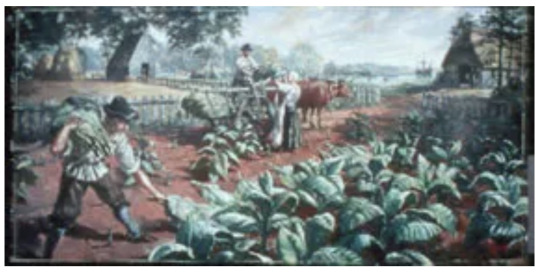
In 1619, the first documented Africans were captured and brought to Virginia to work the tobacco fields.
In 1619, the Virginia Company recruited and shipped over about 90 women to become wives and start families in Virginia.
Peace between the Powhatan Indians and the English, brought about by the conversion and marriage of Pocahontas (kidnapped by the English in 1613) and John Rolfe in 1614, ended in 1622.
https://www.nps.gov/jame/learn/historyculture/a-short-history-of-jamestown.htm
Looking at what roughly happened back then, there was a lot of suffering and deaths, I could imaging the land being quite messed up and there were bodies that they weren't able to clear at the time. I feel bad for the Indians also, I have no idea why we treated them differently and it surprises me that Pocahontas, one of my favourite Disney movies, portrays John Rolph and Pocahontas as a loving couple when it was actually against her will so the English and the Indians had a treaty.
Looking back at our history, I find people quite disappointed sometimes when they couldn't figure out how to stop simple diseases. I'm lucky I live in a time where I know how to get clean water and that I get it also through the taps in our home. However, it is made that they could find out how to feed themselves, and most people would have trouble being in that situation.
0 notes
Photo
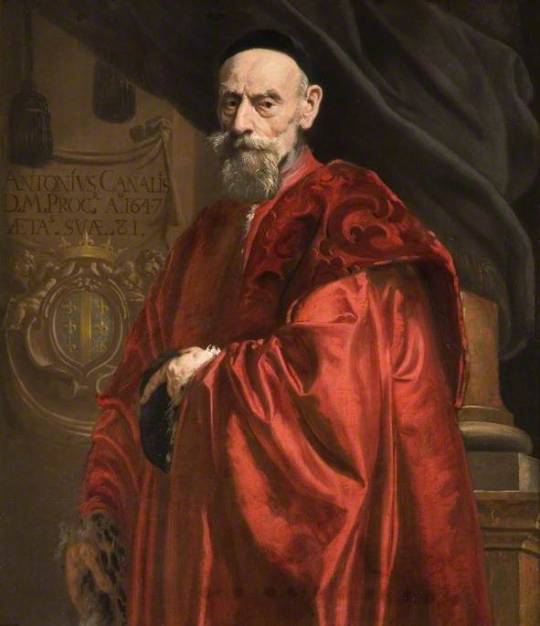
Daniel van den Dyck (Attr.) - Portrait of Antonio Canal - 1647
oil on canvas, height: 113 cm (44.4 in) Edit this at Wikidata; width: 98.4 cm (38.7 in)
Birmingham Museums Trust, UK
Daniel van den Dyck, known in Italy as Daniel Vandich (baptized on 3 December 1614, Antwerp – 1663, Mantua) was a Flemish painter, printmaker, architect and engineer. After training in Antwerp he left for Italy where he first worked in Venice and later became a court painter in Mantua. He was a versatile artist who created mythological and religious scenes, as well as portraits and flower-pieces.
Very little is known about the early life of Daniel van den Dyck. He was born in Antwerp as the son of Jan van den Dyck and Cornelia Kerstboom. He was baptized in Antwerp Cathedral on 3 December 1614. He was registered as a pupil of Peter Verhaeght in the Antwerp Guild of Saint Luke in the guild year 1631-1632. He was registered as a master of the Antwerp Guild of Saint Luke in the guild year 1633-1634. It is assumed that shortly after becoming a master he left Antwerp as he was not involved in any of the large commissions on which Antwerp painters worked in the middle of the 1630s such as the decorations for the Joyous Entry into Antwerp of the new governor of the Habsburg Netherlands Cardinal-Infante Ferdinand and the decorations for the hunting pavilion Torre de la Parada of the Spanish king Philip IV near Madrid.
The artist passed first through Bergamo where he created a few signed and dated portraits. He was in Venice likely from 1634 onwards. Here he married Lucrezia Renieri, the eldest daughter of Nicolas Régnier, a Flemish painter active in Venice who was herself a painter. The couple had three sons. His father-in-law had been active in Venice since 1626 not only as a painter but also as an art dealer and art collector. Clorinda, the younger sister of van den Dyck's wife was married to the prominent Italian painter Pietro della Vecchia (1605-1678). These family ties meant that van den Dyck could rely on a network of Flemish and Italian artists in Venice. This allowed him to gain many commissions for religious paintings in churches as well as for portraits. He painted wall decorations in the Palazzo Pesaro in Preganziol together with his brother-in-law della Vecchia and their respective spouses.
Evidence of the esteem in which he was held in his time is the fact that one of his works - a portrait - was included in the early biographer Carlo Ridolfi's book on Venetian painters of 1648 entitled Le maraviglie dell'Arte ovvero, Le vite degli Illustri Pittori Veneti and dello Stato. He was also praised by Marco Boschini in his La carta del navegar pitoresco of 1660, a panygeric poem about Venetian painting. Boschini dedicated two pages to van den Dyck and represented the artist in a print as Jupiter embellishing Virtue with a royal mantle.
Giovan Francesco Loredano, one of the founders of the Accademia degli Incogniti, a learned society of freethinking intellectuals established in 1630 in Venice, often ordered the illustrations for his multiple writings from van den Dyck, Pietro della Vecchia and Francesco Ruschi.[3] One of these prints was a portrait of Loredano which he made for Loredano's Opere (Collected works).
From late 1657 van den Dyck was living with his family in Mantua. On 2 April of the next year he was named by duke Carlo II Gonzaga as his official court painter, architect, surveyor of his building program and engineer for stage designs for the theatre. He also was made the superintendent of the duke's gallery and tasked with reconstituting the ducal art collection which had become dispersed during the previous two dukes' reign. Possibly his appointment was made on the recommendation of his father-in-law who had provided services to the duke on various occasions. As the prefetto delle fabbriche (surveyor of works) van den Dyck had to move between the various construction sites such as Maderno, Marmirolo, Mantua and Venice, to check the transportation of the many marble statues, inspect the progress and quality of the various construction works undertaken at the ducal palace as well as the suburban residences, ordered supplies and tools, organized the daily assignments of the workers and made sure the duke was informed timely through frequent correspondence. The constant and exhausting travel in this role did not allow van den Dyck to work as a painter, the premier reason for his appointment to the court. This may explain why van den Dyck operated a large workshop with assistants. These assistants would produce his works which he would then 'touch up'.
The date of his death is not known with certainty. It is placed shortly after he drew up his will on 27 June 1662. On 4 April 1663 the duke of Mantua appointed another Flemish painter called Frans Geffels as his new court painter. Van den Dyck's son may have become a painter as his grandfather Nicolas Régnier bequeathed onto him all his prints, drawings and reliefs to study.
22 notes
·
View notes
Note
This is the timeline I've put together and follow for my stuff (includes my headcanons for surnames, birthdays and ages for some characters). Not sure how accurate to canon all of it is, but here you go.
(Putting it under the cut bc this got pretty long)
1579: March 22nd Birth of Orsi Orfai
1584: October 8th Birth of Kaiser Granvorka
1585: August 31st Birth of Acier Silva
1591: March 12th Birth of Zara Ideale October 15th Birth of Julius Novachrono (?)
1594: March 22nd Orsi Orfai turns 15
1595: March 15th Orsi Orfai obtains his grimoire
1599: October 8th Kaiser Granvorka turns 15
1600: March 15th Kaiser Granvorka obtains his grimoire August 31st Acier Silva turns 15 September 28th Magic Knight Entrance Exams: Kaiser Granvorka joins the Purple Orcas
1601: January 16th Birth of Revchi Salik March 15th Acier Silva obtains her grimoire June 8th Birth of Xerx Lugner July 26th Birth of Mereoleona Vermillion September 28th Magic Knight Entrance Exams: Acier Silva joins the Silver Eagles October 2nd Birth of Tenmanyashiki Fujio
1602: January 8th Birth of Randall Luftair
1603: August 5th Birth of Fuegoleon Vermillion
1604: December 30th Birth of Nozel Silva
1605: January 20th Birth of Mushogatake Yosuga April 30th Birth of Nacht Faust May 1st Birth of Morgen Faust June 1st Birth of Jack Summerfield July 23rd Birth of Ryuuda Ryuuya September 17th Birth of Yami Sukehiro October 7th Birth of Fanzell Kruger December 5th Birth of Gueldre Poizot
1606: March 12th Zara Ideale turns 15 March 15th Zara Ideale obtains his grimoires March 21st Birth of Dorothy Unsworth May 21st Birth of Morris Libardirt September 18th Birth of Charlotte Roselei October 15th Julius Novachrono turns 15 (?)
1607: January 13th Birth of Gordon Agrippa February 9th Birth of Puli Angel February 12th Birth of Henry Legolant March 15th Julius Novachrono obtains his grimoire (?) July 2nd Birth of Lily Aquaria September 15th Birth of Dominate Code September 28th Magic Knight Entrance Exams: Julius Novachrono joins the Grey Deer December 24th Birth of William Vangeance
1608: June 12th Therese Rupal is hired as governess for Mereoleona and Fuegoleon Vermillion October 21st Birth of Marx Francois October 24th Birth of Cob Portaport December 19th Birth of Zora Ideale December 21st Birth of Valtos Landvik
1609: January 3rd Birth of Alecdora Sandler February 20th Birth of Grey Wechsler May 16th Birth of Vanessa Enoteca September 3rd Birth of En Ringard October 23rd Birth of Nebra Silva
1610: February 5th Birth of Hangatsuji Juzo May 23rd Birth of Imari Komari October 27th Birth of Kezokaku Ginnojomorifuyu
1611: May 9th Birth of Yami Ichika November 15th Acier Silva becomes Captain of the Silver Eagles
1612: February 6th Birth of Finral Roulacase February 21st Birth of Lolopechka Kozma October 17th Birth of Rades Spirito
1613: January 12th Birth of Cornelia Franklin February 21st Birth of Fragile Tormenta April 1st Birth of David Swallow April 21st Birth of Hamon Caseus April 24th Birth of Kirsch Vermillion August 23rd Birth of Letoile Becquerel September 23rd Birth of Langris Vaude
1614: January 8th Birth of Mars Starr March 16th Birth of Rill Boismortier March 24th Birth of Fana Bergen June 3rd Birth of Charmy Pappitson June 27th Birth of Gauche Adlai July 4th Birth of Ladros Dorthonion
1615 February 26th Birth of Solid Silva April 7th Birth of Magna Swing April 19th Birth of Klaus Lunettes May 13th Birth of Sol Marron October 11th Birth of Luck Voltia
1616: January 16th Revchi Salik turns 15 March 15th Revchi Salik obtains his grimoire March 17th Birth of Sally Bullard June 8th Xerx Lugner turns 15 July 26th Mereoleona Vermillion turns 15 August 10th Birth of Leopold Vermillion September 28th Magic Knight Entrance Exams: Revchi Salik joins the Purple Orcas
1617: January 8th Randall Luftair turns 15 March 15th Mereoleona Vermillion, Xerx Lugner and Randall Luftair obtain their grimoires. Tenmanyashiki Fujio obtains his scroll. August 16th Birth of Mimosa Vermillion August 29th O’oka Daisaemon turns 15 September 28th Magic Knight Entrance Exams: Mereoleona Vermillion and Randall Luftair join the Crimson Lion Kings, Xerx Lugner joins the Purple Orcas Septermber 30th The Zogratis Siblings take over the Spade Kingdom, killing King Loyce Grinberryall and driving Queen Ciel Grinberryall into hiding. October 4th Asta Lykke and Yuno Grinberryall found at the church November 15th Birth of Noelle Silva
1618: March 15th O’oka Daizaemon obtains his scroll. August 5th Fuegoleon Vermillion turns 15
1619: February 7th Yami Katsurō feeds Yami Sukehiro and Yami Ichika. Demon Soul Pills and the three of them slaughter the rest of the Yami clan. Yami Sukehiro kills Yami Katsurō. Yami Sukehiro is banished for the massacre of the Yami clan. February 14th Yami Sukehiro washes up in Clover March 9th Peter Summerfield, father of Jack Summerfield, dies March 15th Fuegoleon Vermillion obtains his grimoire April 10th Vanica Zogratis attacks and curses Acier Silva and Nozel Silva June 22nd Charlotte Roselei is cursed September 28th Magic Knight Entrance Exams: Fuegoleon Vermillion joins the Crimson Lion Kings October 13th Acier Silva dies November 23rd Jack Summerfield kills the Lord of the Mountain December 30th Nozel Silva turns 15
1620: January 20th Mushogatake Yosuga turns 15 March 15th Nozel Silva obtains his grimoire, Mushogatake Yosuga obtains his scroll April 30th Nacht Faust turns 15 May 1st Morgen Faust turns 15 June 1st Jack Summerfield turns 15 July 23rd Ryuuda Ryuuya turns 15 September 17th Yami Sukehiro turns 15 September 28th Magic Knight Entrance Exams: Nozel Silva joins the Silver Eagles October 7th Fanzell Kruger turns 15 November 22nd Julius Novachrono becomes Captain of the Grey Deer December 5th Geuldre Poizot turns 15
1621: March 15th Nacht Faust, Morgen Faust, Jack Summerfield, Yami Sukehiro, Fanzell Kruger and Gueldre Poizot obtain their grimoires, Ryuudou Ryuuya obtains his scroll March 21st Dorothy Unsworth turns 15 May 21st Morris Libardirt turns 15 September 18th Charlotte Roselei turns 15 September 28th Magic Knight Entrance Exams: Morgen Faust and Yami Sukehiro join the Grey Deer, Jack Summerfield joins the Green Praying Mantises, Zara Ideale and Gueldre Poizot join the Purple Orcas. October 16th Damnatio Kira turns 15
1622: January 13th Gordon Agrippa turns 15 February 9th Puli Angel turns 15 February 12th Henry Legolant turns 15 March 15th Dorothy Unsworth, Morris Libadirt, Charlotte Roselei, Gordon Agrippa, Puli Angel and Henry Legolant obtain their grimoires July 2nd Lily Aquaria turns 15 September 15th Dominate Code turns 15 September 28th Magic Knight Entrance Exams: Dorothy Unsworth joins the Coral Peacocks, Charlotte Roselei and Puli Angel join the Blue Rose Knights December 24th William Vangeance turns 15
1623: March 15th Dominante Code and William Vangeance obtain their grimoires September 28th Magic Knight Entrance Exams: William Vangeance joins the Grey Deer June 17th Nacht Faust’s ritual to summon Lucifugus goes wrong. Morgen Faust dies. October 21st Marx Francois turns 15 October 24th Cob Portaport turns 15 December 19th Zora Ideale turns 15 December 21st Valtos Landvik turns 15 December 21st Birth of Marie Adlai
1624: January 3rd Alecdora Sandler turns 15 February 20th Grey Wechsler turns 15 March 15th Silas Vaude, Lily Aquaria, Marx Francois, Cob Portaport, Zora Ideale, Valtos Landvik, Alecdora Sandler and Grey Wechsler obtain their grimoires May 16th Vanessa Enoteca turns 15 September 3rd En Ringard turns 15 September 28th Magic Knight Entrance Exams: Marx Francois, Cob Portaport, Alecdora Sandler joins the Grey Deer October 23rd Nebra Silva turns 15
1625: February 5th Hangatsuji Juzo turns 15 March 15th En Ringard and Nebra Silva obtain their grimoires. Hangatsuji Jozo obtains his scroll May 23rd Imari Komari turns 15 September 28th Magic Knight Entrance Exams: Nebra Silva joins the Silver Eagles, En Ringard joins the Green Praying Mantises October 27th Kezokaku Ginnojomorifuyu turns 15
1626: March 15th Shiren Tium obtains his grimoire. Imari Komari and Kezokaku Ginnojomorifuyu obtain their scrolls May 9th Yami Ichika turns 15 June 15th Yami Sukehiro crashes into the Forest of Witches and frees Vanessa Enoteca June 26th Vanessa Enoteca Obtains her grimoire July 9th Lord and Lady Adlai are murdered. Their children Gauche and Marie Adlai are thrown to the streets. September 28th Magic Knight Entrance Exams: Shiren Tium joins the Grey Deer.
1627: February 6th Finral Roulacase turns 15 February 21st Lolopechka Kozma turns 15 March 15th Finral Roulacase and Lolopechka Kozma obtain their grimoires, Yami Ichika obtains her scroll March 29th Julius Novachrono becomes the twenty-eighth Wizard King. October 17th Rades Spirito turns 15
1628: February 21st Fragile Tormenta turns 15 March 15th Rades Spirito, Cornelia Franklin and Fragil Tormenta obtain their grimoires March 30th The Twenty-Eighth Wizard King, Julius Novachrono, introduces the Star Festival and the Star Ranking System for the Magic Knights. Yami Sukehiro is declared the first Captain of the Black Bulls and William Vangeance is declared the first Captain of the Golden Dawn. March 31st William Vangeance takes Alecdora Sandler and Shiren Tium to start the Golden Dawn. April 1st David Swallow turns 15 April 24th Kirsch Vermillion turns 15 April 27th Vanessa Enoteca joins the Black Bulls August 23rd Letoile Becquerel turns 15 September 23rd Langris Vaude turns 15 September 28th Magic Knight Entrance Exams: Rades Spirito joins the Purple Orcas, Fragil Tormenta joins the Grey Deer, Finral Roulacase joins the Black Bulls November 9th Gordon Agrippa joins the Black Bulls
1629: January 8th Mars Starr turns 15 March 15th Davis Swallow, Hamon Caseus, Kirsch Vermillion, Letoile Becquerel, Langris Vaude, Mars Starr obtain their grimoires March 16th Rill Boismortier turns 15 June 3rd Charmy Pappitson turns 15 June 27th Gauche Adlai turns 15 July 4th Ladros Dorthonion turns 15 September 28th Magic Knight Entrance Exams: Kirsch Vermillion joins the Coral Peacocks, David Swallow, Hamon Caseus, Letoile Bequerel and Langris Vaude join the Golden Dawn.
1630: March 15th Rill Boismortier, Fana Bergen, Charmy Pappitson, Gauche Adlai, Ladros Dorthonion and Solid Silva obtain their grimoires April 7th Magna Swing turns 15 April 10th Grey Wechsler runs away from home and is helped by Gauche Adlai April 19th Klaus Lunettes turns 15 May 13th Sol Marron turns 15 July 24th Gauche Adlai is arrested and Marie Adlai is sent to the Church Orphanage in Nean September 28th Magic Knight Entrance Exams: Rill Boismortier joins the Grey Deer, Solid Silva joins the Silver Eagles October 11th Luck Voltia turns 15 October 19th Grey Wechsler joins the Black Bulls November 7th Charmy Pappitson joins the Black Bulls
1631: February 26th Solid Silva turns 15 March 15th Magna Swing, Klaus Lunettes, Sol Marron and Luck Voltia obtain their grimoires March 17th Sally Bullard turns 15 June 17th Revchi Salik and Rades Spirito are expelled from the Purple Orcas August 10th Leopold Vermillion turns 15 September 28th Magic Knight Entrance Exams: Magna Swing and Luck Voltia join the Black Bulls, Klaus Lunettes joins the Golden Dawn, Sol Marron joins the Blue Rose Knights December 23rd Gauche Adlai escapes from jail
1632: January 2nd Yami Sukehiro tracks Gauche Adlai down and offers him a position in the Black Bulls March 15th Sally Bullard and Leopold Vermillion obtain their grimoires April 22nd Sekke Bronzazza turns 15 August 16th Mimosa Vermillion turns 15 September 28th Magic Knight Entrance Exams: Leopold Vermillion joins the Crimson Lion Kings October 4th Asta Lykke and Yuno Grinberryall celebrate 15 years at the church November 15th Noelle Silva turns 15
1633: March 15th Sekke Bronzazza, Aella Clarkson, Mimosa Vermillion, Asta Lykke, Yuno Grinberryall, Mariella Keller and Noelle Silva obtain their grimoires September 26th Mimosa Vermillion joins the Golden Dawn, Noelle Silva joins the Black Bulls September 28th Magic Knight Entrance Exams: Sekke Bronzazza joins the Green Praying Mantises, Asta Lykke joins the Black Bulls, Yuno Grinberryall joins the Golden Dawn.
Ik this is so random but I'm so confused about the ages of the Silva's and the timeline. Because tabata mentioned that acier silva passed away at the age of 32 but if you see her headstone she technically passed away at 35.
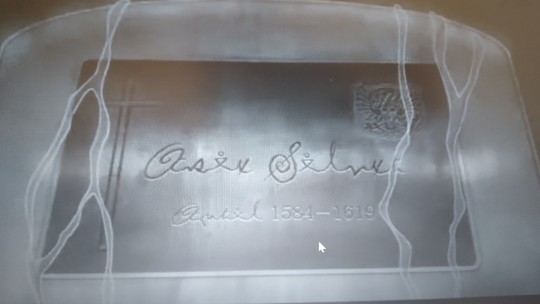
And if you follow the the headstones then noelle must've been born at year 1619 but if you follow the character profile then its year 1617.
Unless this scene is filler cause I'm not sure I've seen it in the manga.
I don't think it's that random, but also, I can't blame you for being a bit confused with the timeline (and... I can't say that I'm 100% confident in mine either, but I'm like 90% sure), but also I am weary of trusting the anime, over manga, or material from the manga. Also, I have seen a few time lines composed by fellow fans, some of which differ slightly from mine.
Anyway, the general consensus among the people I know, 1584 is Acier's year of birth, and Acier's character profile has her dead at the age of 33.

The difference of one year we can quite easily put up to Tab's memory, but I'm taking it as 33. However, this is where things get a bit confusing, but I have a theory as to why her age at death is said to be 33.
This would mean that she turned 33 in August of 1617. Noelle was born in November of that same year.
After Noelle's birth, Acier takes all the kids to another estate, away from the Capitol, where they're subjected to Megicula's attack, where Nozel cradles the new born Noelle while trying to protect her, as Acier kick's ass despite ending up with the curse. (I'm saying 'kicks ass' because Megi fled.) This would have to be, at the earliest, in December of 1617.
Since the curse has said to have killed Acier in a year, this would be in 1618, or possibly early 1619. In August of 1618, Acier would have turned 34, and my theory is that the reason why the age of 33 is placed on the character sheet are that:
It would have been a plot spoiler (of a kind) if he had made her age at death be more
She was dying "for sure" at the age of 33. Essentially, she was "as good as dead" at that age when the curse was placed on her.
But her physical death didn't happen until 1618 or 1619, at the age of 34, when Noelle was just over 1 year old.
Of course it'd be possible for Acier to have died before the 1 year was completely up, somewhere before August of 1618, but I think this is a matter of no one thinking that the fans would start working this thing out.
These are some of the births, deaths, and profile ages I have in my doc.

So, I'm not entirely sure about if the ages and years are fact checked, but we do know that Noelle had been born before the Megicula attack, because otherwise we wouldn't have the panel of Nozel cradling Noelle. So, it wasn't Noelle's birth that killed Acier. Even if for the royals it was easy to blame Acier's death on Noelle weaking her (Acier's) body, and since Nozel suffered from the "inability to speak" curse from the background curse magic, he couldn't really say anything.
Anyways, I hope this helps ^^
26 notes
·
View notes